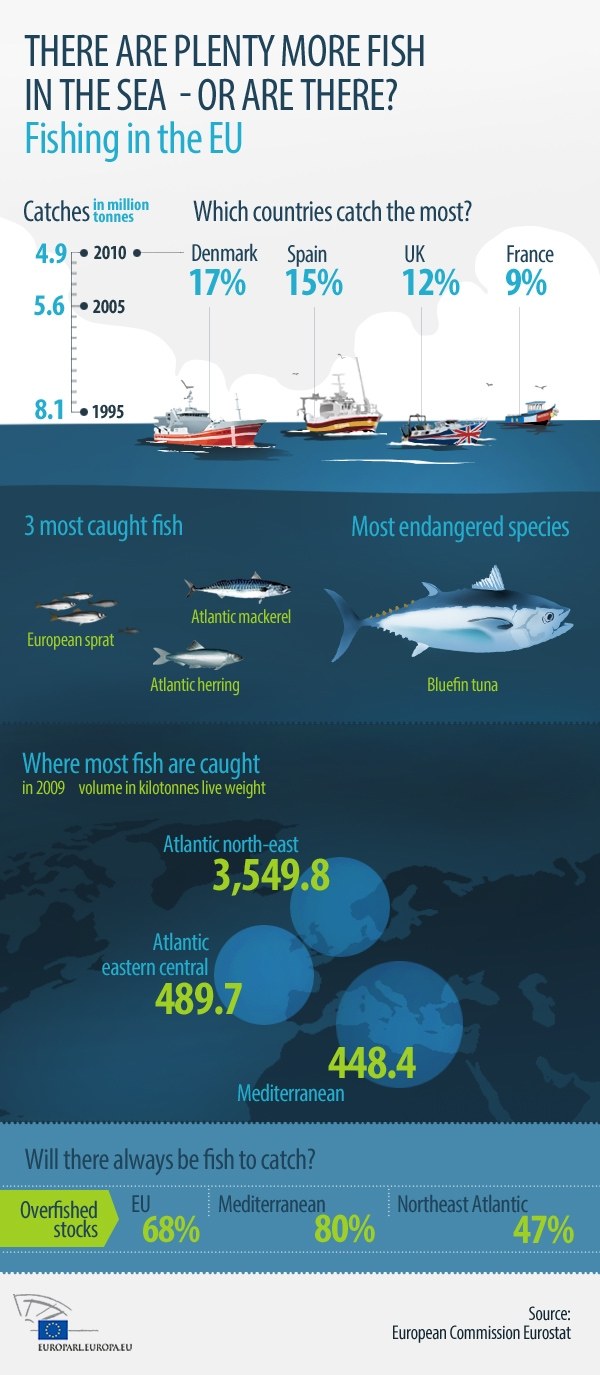Members of the European Parliament voted this week to approve a reform of the EU’s Common Fisheries Policy (CFP). The policy aims to cut fishing to a level that creates sustainable stock levels, and while it’s already had some success at reducing annual catches over the last 7 years, the Parliament have added their official voice to the reality that many of the seas in and around Europe are still over-fished.
According to stats released by the European Commission Eurostat, catches have been successfully reduced from 8.1 million tonnes in 1995 to 4.9 million tonnes back in 2010. However, the statistics also show that too many fish are still being caught, with 68% of EU stock being over-fished, a staggering 80% in the Mediterranean and 47% in the North Eastern Atlantic.
The approved policy reform’s aim is not just to cut fishing levels, but it is also planned to cover the end to dumping at sea, as well as creating long term plans for fishing based on scientific research and data. This should help to ensure that future stocks of fish remain sustainably available and safeguard the ecology of sea life in the seas and oceans impacted by the European fisheries industry.
While some from the fisheries industry claim that jobs have been lost as a result of fishing reform in EU states, the counter argument to this has always been that jobs will inevitably be lost until fishing is carried out sustainably, because the stock levels would reduce year on year until there isn’t enough for businesses to continue. If you keep taking more fish out of the sea than can feasibly replenish, it doesn’t take an A Level in fish science to work out that you’ll eventually have to lay off a few of the chubbier, slower trawler hustlers.
One of the most contentious elements of the reform is the end of dumping unwanted catch back into the sea. This is predominantly because of undersized or unwanted species hauls, which leads to a much larger overall volume of fish stock being caught than actually finds itself back to the docks.
The reform will mean that fishing vessels will need to bring in everything that they catch, so that they won’t be able to throw back the less lucrative elements of the haul to bring in more of their target catch. While this will inevitably mean that vessels make less money per round trip, making it not that popular in the large scale fishing community, it should force the industry to look for new innovations to improve the efficiency of their fishing practices.
The reform will also legislate the quota for catches attributed to its member states, meaning that they won’t be able to set quotas that are too high to be sustainable. The aim is to bring this in for 2015, preventing fishermen (/people) from catching more than a given stock can sustainably replenish in a year.
Now that the reform has been approved the next stage is for the Parliament to commence negotiations with the European Council and the Commission on the reform plans before it gets a second reading. While the Parliament can make a proposal for legislation, it needs the Commission to draft a bill before anything can become law, so there is more to do before EU states move to a truly sustainable fishery policy, but the move is a significant step forward.
Here’s the European Commission Eurostat’s infographic on overfishing for more details on the stats:
© European Union 2013 – European Parliament



